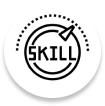-
Customized L&D
-
Bench Skilling
Bench Skilling
Our bench skilling programs have consistently delivered outstanding results for our clients. For instance, a global IT firm experienced a significant boost in project readiness and a notable reduction in onboarding time after their team completed our program. Similarly, a leading software company reported enhanced employee engagement and skill levels, which enabled them to tackle more complex projects with greater efficiency.
These success stories highlight the tangible benefits and positive outcomes of our bench skilling services, demonstrating their value to your organization

Tailored Training
We offer customized training programs designed to address the specific needs of each corporate client, ensuring relevant and impactful learning experiences.

Hands-On Training
Our programs emphasize practical application, allowing your team to implement new skills immediately and see tangible improvements in performance and productivity.

Expert Instructors
Learn from seasoned industry professionals who bring practical, real-world experience into the classroom, enhancing the learning experience.

Dual Benefits
Investing in our bootcamp services not only boosts the capabilities of your workforce but also contributes to overall organizational growth.
How to Get Started With Us
Identify Skill Gaps and Goals
Skill Assessment: Conduct a thorough assessment to identify the current skills of your bench resources and the gaps that need to be filled. Set Objectives: Define clear goals for the upskilling or reskilling program, such as preparing employees for new projects, enhancing their current skills, or transitioning them to new roles.
Develop a Customized Training Plan
Tailored Curriculum: Create a training plan that addresses the specific needs of your bench resources, focusing on relevant technologies, tools, and methodologies. Diverse Learning Methods: Incorporate various learning methods such as online courses, workshops, hands-on projects, and mentorship programs to cater to different learning styles.
Implement Training Programs
Learning Management System (LMS): Utilize an LMS to deliver, track, and manage the training programs efficiently. Interactive Tools: Use interactive tools like simulations, gamification, and virtual labs to make the training engaging and effective.
Evaluate and Iterate
Feedback Collection: Gather feedback from participants to assess the effectiveness of the training programs and identify areas for improvement. Continuous Improvement: Regularly update the training content and methods based on feedback and the latest industry trends to ensure the programs remain relevant and effective.
